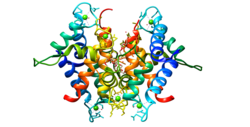Les variants du gène induisant une perte de fonction est l'un des facteurs prédisposants les plus importants de la dermatite atopique[3]. Ils augmentent également le risque de survenue d'un eczéma ou d'un asthme[4]. D'autres variants, plus rares, prédisposent à l'ichtyose vulgaire[5].
Le chromosome 1 peut comporter également plusieurs copies du gène, dont le nombre est en rapport avec un risque plus important de développer une dermatite atopique[6].
- ↑ a b et c GRCh38: Ensembl release 89: ENSG00000143631 - Ensembl, May 2017
- ↑ « Publications PubMed pour l'Homme », sur National Center for Biotechnology Information, U.S. National Library of Medicine
- ↑ Palmer CN, Irvine AD, Terron-Kwiatkowski A et al. Common loss-of-function variants of the epidermal barrier protein filaggrin are a major predisposing factor for atopic dermatitis, Nat Genet, 2006;38:441-446
- ↑ Rodríguez E, Baurecht H, Herberich E et al. Meta-analysis of filaggrin polymorphisms in eczema and asthma: robust risk factors in atopic disease, J Allergy Clin Immunol, 2009;123:1361-1370
- ↑ Sandilands A, Terron-Kwiatkowski A, Hull PR et al. Comprehensive analysis of the gene encoding filaggrin uncovers prevalent and rare mutations in ichthyosis vulgaris and atopic eczema, Nat Genet, 2007;39:650-654
- ↑ Brown SJ, Kroboth K, Sandilands A et al. Intragenic copy number variation within filaggrin contributes to the risk of atopic dermatitis with a dose-dependent effect, J Invest Dermatol, 2012;132:98-104


